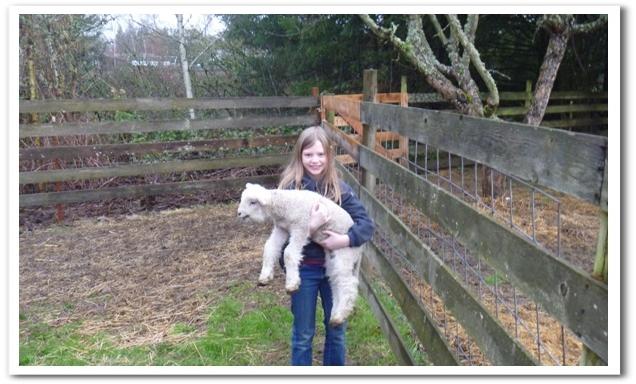
A nna Rose Farm raises registered Romney Sheep. The breed is truly versatile, demonstrated by its ability to produce quality meat and wool under diverse climate conditions and management systems. This breed’s quiet disposition, unique fleece characteristics, the flavor and quality of its meat and its lambing percentage make it an excellent choice for purebred, commercial, or crossbred programs. These same characteristics, plus the hand spinning qualities of the fleece, also make the breed attractive to the small, or spinners flock.
T he Romney’s versatility, as a top producer of both meat and wool, has enabled breeders to select for different traits in their breeding programs. Some emphasize large, long-bodied, fast-growing rams to produce market lambs. Many young people will find Romneys to be an ideal breed for showing and for establishing a purebred flock. Because Romneys are of quiet temperament and readily bond to a youth who spends time with them, they are easily trained for the show ring.
B omney fleeces also offer a second opportunity to participate in fairs or shows because they often place very high in shows and frequently sell to hand spinners directly from shows. Since Romney wool is one of the easiest to spin by hand, many younger shepherds learn to spin and may participate in spinning contests. Some create garments from their Romney wool and participate in lead line classes or make-it-yourself-with-wool events.
M any younger shepherds are increasingly turning to Romneys when selecting a breed to raise for project lambs. With some grain and good management, the lambs will reach an ideal 110-to-120 pound market weight in four-to-six months. Excellent market lambs can also be produced by crossing with any traditional meat breed.
Sheep and Noxious Weeds
One of the greatest threats to public, private and agricultural lands as well as Oregon’s streams are the spread of noxious weeds such as Himalayan Black Berries, Scotch Broom, Canary Grass, and many others killing off surrounding vegetation, causing soil erosion, and severely damaging aquatic and native plants and animals. Managing weeds with herbicides is costly and manual clearing can be difficult or ineffective. Sheep are unique in that they are able to consume plants toxic to other animals. Land managers are now turning to sheep grazing as an environmentally sound and cost effective method way to control noxious and invasive weeds. Leafy spurge is estimated to infest 3 million acres of farm and public land in 26 northern states alone. In Montana, the BLM saved $40-$50 per acre of land by using sheep to graze land to control spurge. Sheep have been used in North and South Dakota, Wyoming, Oregon .Washington and Montana by Universities and Wildlife Services to control spotted knapweed, leafy spurge, fringed ragwort, kudzu among other noxious weeds. (‘Sheep and Noxious Weed Control,” American Sheep Industry Pamphlet)
Sheep and the Environment
Sheep are Earth-friendly animals, no matter where they graze. They are efficient converters of renewable forage to high-quality food and fiber. In many areas of the country, sheep are used to graze leftover stalks and seeds after crops have been harvested. Sheep also help control weeds in ditch banks, roadsides and pastures, cutting in range operations sheep have been successful in suppressing brush for wildfire control. They also are effective in weed control in new forest plantings. Following well-planned rotational grazing; sheep are safely and naturally reviving lands and benefitting wildlife in the process. Sheep harvest the land; recycle vital nutrients back to the soil and provide man with nourishment and shelter.[/one_half]


